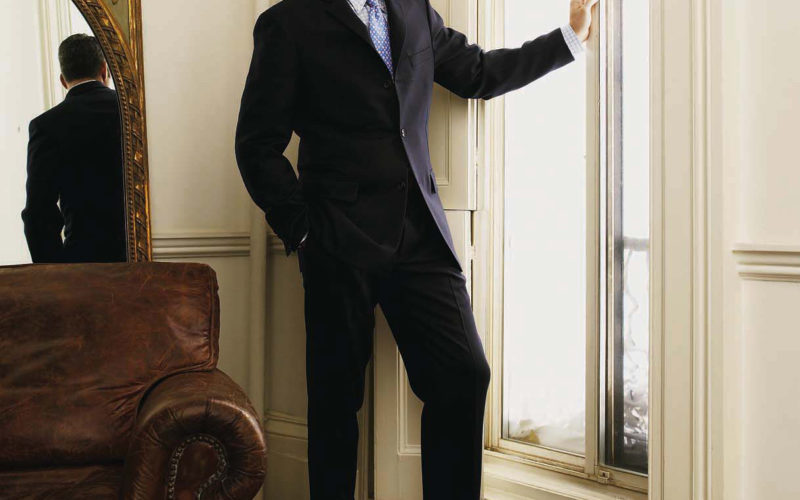Q. On the cover of the recent issue of Esquire, Yusef Salaam is wearing a great looking suit. I liked the fabric and the fit. He looks so terrific that it has inspired me to invest in a good suit. But it seems like a daunting task to choose just the right one. Where would I start? What should I choose as my first basic suit?
A. It is impressive that you noticed the suit’s fabric and quality from the photograph. The clothing industry offers a wide variety of suits to choose from and it is not always easy to know where to begin.
When shopping for a suit, the major categories to consider are: the cut of the suit, the fabric it is made of, its quality, and the fit.
When it comes to cut, suits are either single-breasted or double-breasted. The suit you saw Salaam wearing was a double-breasted style; and that is fine for a man with a closet full of suits. But a double-breasted should not be a man’s first suit. Double-breasteds are much dressier than single-breasteds and in some environments might risk coming across as ostentatious. A single-breasted suit is the most versatile and can be dressed up or down to suit the occasion. It is a much better choice for a beginning suit wardrobe.
The next thing to consider is fabric. Definitely, a man’s first suit (and maybe even the next few) should be wool. What a lot of men do not know is that wool comes in various weights. You have choices.
Sometimes a heavier-weight wool is a nice alternative for cooler weather. The clothing industry’s variety of weights for men’s wool clothing ranges from winter-weights, to year-‘round weights, and the not-so-well-known (and not-so-easy-to-find) tropical-weight wools that many well-dressed men favor for summer wear. On the other hand, a lot of men dislike wearing heavier weights because their offices are kept at an even temperature all year, making heavy weights too warm. Wool weights include:
• 6.5-8.5 oz: These are considered lightweight and are great for men who live in warm climates.
• 9-10 oz: These mid-weight cloths are considered “all-season” wools.
• 12.5-14 oz: These heavier weight cloths are geared towards autumn and winter suiting fabrics.
If your budget does not allow you to invest in seasonal suits, I recommend you choose year-round weight wool (mid-weight).
Here is another way to categorize men’s suits. In menswear shops you will come across such terms as “Super 120’s wool,” or “Super 150’s wool,” or something similar. A wool’s “super” number indicates its quality; the higher the number, the finer the wool. This description can help you when choosing your suit.
The fit of a suit is extremely important. Even the finest quality suit will not look good if it does not fit you perfectly. When shopping for your suit, be sure you try it on (wearing the right shoes) while the store’s tailor is checking it out for you. Pay attention to what he has to say and follow his suggestions. Several types of alterations are included in the price of the suit, and even those that are not should not be ignored. A perfect fit is worth every penny (or dollar) you pay.
You may be wondering how to maintain your new suit. Should you clean it often? No. Over-cleaning is not good for the fabric. If it is soiled, clean it; if it is merely wrinkled, have it pressed. And always be sure to dry clean both parts so the cleaning process does not alter the color of one of the items. Also, you don’t have to use moth balls (with their identifiable odor); instead, keep a few inexpensive cedar blocks in your closet. When you are seasonally storing a suit, be sure it is clean. Then, keep it in a zippered plastic suit bag to avoid “critters.”
My suggestion is to buy a single-breasted, mid-weight wool in either one of the two most versatile colors, navy blue or charcoal gray, depending upon your preference.
To return to the recent Esquire magazine cover, oftentimes young men consult men’s fashion magazines to learn what is and is not acceptable in the world of business. I fear that if a young man were reading this magazine for direction, this example might lead him astray. Although I certainly admire Salaam’s choice and respect your plan to upgrade your wardrobe, I do want to add one note of caution. If you are looking for what is traditionally accepted as good taste in business-appropriate clothing, don’t accept everything in the photograph on the cover.
Salaam was wearing a traditionally conservative double-breasted suit, a white dress shirt with a spread collar, and a handsome necktie in a well-tied half-Windsor knot. But in addition to these tasteful, dressy choices, he was also wearing a somewhat flashy collection of jewelry that conservative dressers might well consider “too much.”
Please send your men’s dress and grooming questions to MALE CALL: Lois.Fenton@prodigy.net









